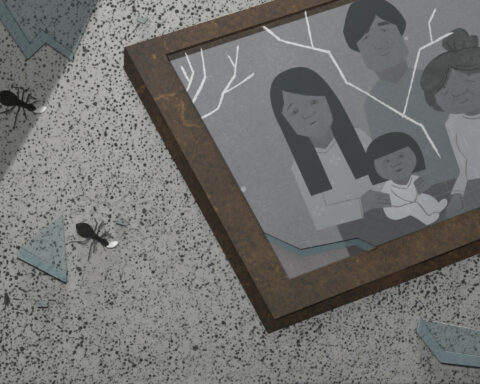THE DOCUMENTARY HIGHLIGHTS of the 2014 Toronto International Film Festival hit a peak with a headline-ready statement from Oscar-winning filmmaker Michael Moore (Bowling for Columbine, 2002), who claimed that documentaries need to be more entertaining. “People want to go home and have sex after your movie,” Moore cheekily pointed out to a group of industry professionals attending the TIFF’s sixth annual Doc Conference. Moore’s salacious sound bite captured the razor-edge of the conference’s discussion about the current state of the doc.
TIFF programmer Thom Powers, who oversees the conference and the TIFF Docs and Mavericks programmes, appreciated Moore’s role as a provocateur. As a programmer, he says, “I want to emphasize the cinematic qualities of the films… [When you talk about documentaries, some] assume a film as dry and formulaic.” In an interview with POV during the festival at TIFF Bell Lightbox’s Canteen restaurant, Powers furthered Moore’s argument by encouraging filmmakers to start “thinking about documentaries as films and not as documentaries.” He good-naturedly admitted that he is fond of the word “documentary” designating something that is “adhering to a different kind of truth,” and says that he’s not yet ready to abandon the word.
The diverse selection of cinematically engaging and intellectually stimulating films in the TIFF Docs programme furthers Powers’ sentiment that “documentary” is a valuable word to include in a festival lineup. One of TIFF 2014’s most acclaimed titles, Joshua Oppenheimer’s The Look of Silence, shows that traditional approaches to the documentary form remain positively thrilling. The film continues Oppenheimer’s interrogation of the perpetrators of the 1965-’66 Indonesian mass killings that began in the Oscar-nominated meta-documentary The Act of Killing (a TIFF 2012 hit). While Silence takes a comparatively more conventional approach to documentary, with interviews in place of dramatic re-enactments, the film chillingly puts the lies of the killers in the centre of the frame. The palpable energy with which audiences discuss Silence in relation to Killing suggests that documentaries have a healthy range of modes for delivery. His films reveal different kinds of truth in their respective approaches and, in their own way, provide a kind of entertainment.
The TIFF audiences’ warm embrace of The Look of Silence and other docs with seemingly difficult subject matter suggests that festival audiences approach documentaries with a definition of “entertainment” that differs from other films. Films such as Nick Broomfield’s harrowing investigative essay Tales of the Grim Sleeper (2014), which chills the viewer by drawing out the graver implications behind one case of serial murders from an outsider’s perspective, or Frederick Wiseman’s meditative three-hour portrait of art in National Gallery were both major hits, documentary or otherwise, of the festival. Even more conventionally shot documentaries—like Beats of the Antonov, the Grolsch People’s Choice Award winner for documentary at TIFF 2014—connect with audiences on several levels. The simplicity of Antonov lets the buoyant rhythm of its soundtrack draw out the appeal for diversity and cultural legacy that beats throughout the film. Similarly, the intimately observational I Am Here by Lixin Fan (Last Train Home, 2009) situates one televised singing competition within China’s greater cultural movement. Each film entertains in its own way and finds higher meaning as one engages with the film. TIFF, like Hot Docs, frequently sees audiences line up for hours, just as eager to see the new Alanis Obomsawin documentary as they might anticipate the new Jean-Marc Vallée film at Roy Thomson Hall. Docs, as Powers notes, might be an underdog amidst the celebrity power of film festivals, but they have a unique draw. This year’s festival programme had its own roster of star-studded docs, with Ethan Hawke’s beautifully subtle portrait Seymour: An Introduction and Sean Evans and Rogers Waters’ electrifying rockumentary Roger Waters The Wall. (The latter film turned the VISA Screening Room at the Elgin Theatre into a bona fide rock concert as the epic film shook the theatre with unparallelled energy.)
The fervour of excitement running through the festival’s doc lineup complements the second major talking point of the Doc Conference, the Hot Docs Learning from Documentary Audiences survey. The survey revealed that the role of film festivals is more important than ever for documentary films. While the survey noted that audiences almost universally consume documentaries at home, 83 per cent of them watch documentaries at film festivals. Powers, who also works on the online platform DocClub.com, confidently agrees with the survey’s findings. “It backed up in hard numbers things I feel instinctively,” he says, elaborating that his programming at both TIFF and Doc NYC regularly sells out screenings to audiences who have been trained to view festivals as a source of cinema outside of the mainstream. Home viewing and film festivals therefore have a reciprocal role as they feed audiences and stimulate demand for more non-fictional films across diverse platforms.
Docs might be more readily available than ever thanks to various on-demand services, but TIFF demonstrates that audiences still feel that docs are, as Powers notes, “underserved” in the greater context of the film experience. This finding means that festivals play an important role in highlighting films of value and of affording experiences that incite passionate debates amongst festivalgoers.
Audiences, for example, could easily wait to enjoy the National Film Board’s co-production The Wanted 18 on the NFB’s streaming site, but the hybrid doc seems perfectly tailored for audiences hungry for films that fit their idea of festival fare. This eccentric film by Amer Shomali and Paul Cowan creatively blends interviews with live-action subjects and re-enactments with claymation cows, giving their perspective on the first Intifada in the ceaseless Israel/Palestine conflict. The inventiveness of The Wanted 18 invites audiences to witness a complex chapter of history from a nuanced and often quite humorous perspective. This excellent, but arguably non-commercial, film lets the offerings of TIFF Docs enlighten and entertain audiences with equal measure.
The thrill of enjoying documentaries both as cinematic experience and as intellectual odyssey couldn’t be more apparent in some of the ingenious films at TIFF this year. Marah Strauch’s excellent Sunshine Superman simply demands to be seen on the large plane of a film screen. Sunshine Superman features gorgeous cinematography that makes one feel like one is flying: Strauch presents exhilarating footage of BASE jumpers captured mainly through a 16mm camera affixed to the helmet of subject Carl Boenish as he tempts fate through daring jumps. The adrenaline rush and sensational euphoria of Sunshine Superman provide the same distinctly cinematic adventure that one might have experienced behind 3D glasses during Alfonso Cuarón’s fiction film Gravity at TIFF last year. Strauch, however, frames Boenish’s extraordinary footage within a deeply philosophical context that meditates upon the rights and limits of human experience. It’s simply one of the most profound and breathtakingly life-affirming films of the year, and the scope of the theatrical experience is essential for re-creating the high Boenish feels each time he soars.
Similarly, the extended Q&As of the festival, especially those accompanying the docs in the Mavericks section, offered the distinct element of insight that one hopes to enjoy at a festival. Julie Taymor’s A Midsummer Night’s Dream marked one of the most pleasant surprises of the festival, for the director’s account of staging her visionary take on Shakespeare’s comedy offered a unique perspective on the observational power of film. The camera, as Taymor noted in her extended post-screening discussion with IndieWire’s Anne Thompson, truly gives each audience member the best seat of the house as the unobtrusive documentation of A Midsummer Night’s Dream takes film-mediated drama to new heights. Dream was one of the most unexpected documentary highlights of TIFF 2014 because it brilliantly displays both the dramatic work that Taymor captured on film and the distinctly cinematic character of close ups and shots/reverse shots that makes film far different from theatre. It’s a unique and rousing film.
The Mavericks programme of 2014 also marked the return of filmmaking legend Martin Scorsese to TIFF, with his surprise appearance at the screening of The 50 Year Argument, which is the vivid portrait of The New York Review of Books that he co-directed with David Tedeschi. Scorsese’s perspective on making documentaries in addition to dramatic works highlights both the pros and cons of Michael Moore’s sentiment to do away with the word “documentarian.” Scorsese, as Powers noted while reflecting upon one of the festival’s highlights, views fiction and non-fiction entries in his filmography simply as “films.” There’s no distinction between the two arts to Scorsese, and one grasps this sentiment as The 50 Year Argument brims with the same verve and tempo as GoodFellas.
Scorsese, interestingly enough, praised the same filmmaker who excited much of the doc crowd, citing in his Mavericks discussion the work of Joshua Oppenheimer as having an innovative visual power that inspires deeper conversations about the provocative subjects his film explores. This reiterates Powers’ position that the visual power of films often guides his selection process. Powers looks to the philosophy of the late cinema vérité pioneer Robert Drew, who said that facts and figures fit more easily into a book than a film but that emotions are seen more easily on a screen than a page. This emotional power serves the subject in turn, for, as Powers explained, “drawing on people emotionally in films [inspires] them to seek out more ‘factual’ information elsewhere. What you can do in 90 minutes is make someone so passionate and inspired that they seek out more information.”
This sentiment rings especially true in the strong contingent of short documentaries that played in various corners of the festival programme. Short Cuts Canada and the inaugural Short Cuts International programme featured a handful of notable docs. The visceral Chop My Money (dir. Theo Anthony) stunned audiences in a matter of minutes while the philosophically elegiac A Tomb with a View (dir. Ryan J. Noth) had a poetic open-endedness that invited viewers to contemplate the afterlife. The delightful short Red Alert (dir. Barry Avrich), which screened with the refreshing dramatic feature Wet Bum, was a playfully idiosyncratic ditty on body image and identity.
If the strong selection of documentaries at TIFF 2014 proves anything, it’s that non-fiction films are stronger than ever. New platforms and increased opportunities for digital democracy mean that documentarians are embracing the cinematic and artistic potential of the art form to reach innovative heights. The results are films that easily fulfill the escapist element of cinema, but also provide the intellectual stimulation that elevates films to art. The state of the doc, as TIFF 2014 shows, is a good one.











